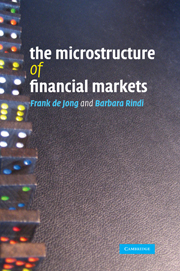Book contents
- Frontmatter
- Contents
- List of figures
- List of tables
- Preface
- Introduction
- 1 Institutions and market structure
- 2 Financial market equilibrium
- 3 Batch markets with strategic informed traders
- 4 Dealer markets: information-based models
- 5 Inventory models
- 6 Empirical models of market microstructure
- 7 Liquidity and asset pricing
- 8 Models of the limit order book
- 9 Price discovery
- 10 Policy issues in financial market structure
- Index
8 - Models of the limit order book
Published online by Cambridge University Press: 05 June 2012
- Frontmatter
- Contents
- List of figures
- List of tables
- Preface
- Introduction
- 1 Institutions and market structure
- 2 Financial market equilibrium
- 3 Batch markets with strategic informed traders
- 4 Dealer markets: information-based models
- 5 Inventory models
- 6 Empirical models of market microstructure
- 7 Liquidity and asset pricing
- 8 Models of the limit order book
- 9 Price discovery
- 10 Policy issues in financial market structure
- Index
Summary
The models presented in the previous chapters describe the price formation process in markets with different structures. As we saw in Figure 1.2, among the markets with trade pricing rules, those governed by an order-driven execution system can be organized either as a continuous or as a call auction, while markets with a quote-driven system can be either a bilateral dealer market or a continuous auction that works as a limit order book. Within this outline, the Glosten and Milgrom (1985) model describes a bilateral quote-driven market in which dealers' competition guarantees semi-strong efficiency; Kyle's (1985) model proxies an order-driven call auction market where a specialist, or a number of market-makers, sets the market-clearing price after observing his, or their, customers' aggregated order flow. Finally, the Grossman and Stiglitz (1980) model proxies an order-driven market where all participants can submit their demand schedules simultaneously. Since each demand function is a fairly accurate representation of a large number of small limit orders (Brown and Zhang, 1997), this market can be interpreted as a limit order book. As the next section shows, this interpretation has the advantage of considering all market participants as potential liquidity suppliers, i.e. of embodying the order-driven feature of a limit order book (LOB); it fails, however, to incorporate either the discriminatory pricing rule that characterizes an LOB or the agents' strategic choices between limit orders and market orders.
Information
- Type
- Chapter
- Information
- The Microstructure of Financial Markets , pp. 127 - 158Publisher: Cambridge University PressPrint publication year: 2009
